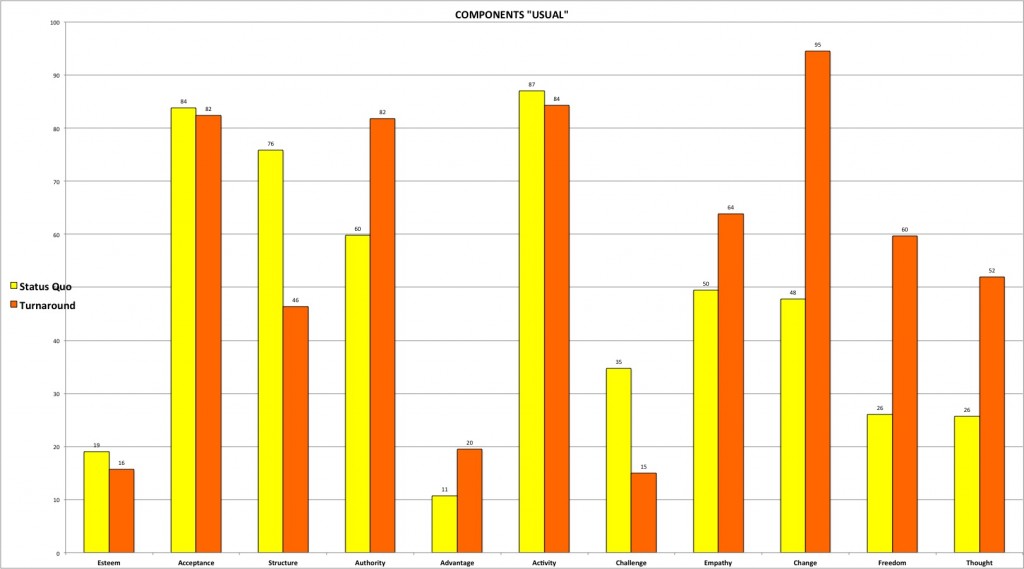
“Let me tell you about the very rich. They are different from you and me.”1
F. Scott Fitzgerald’s pungent observation of the rich can be said of Turnaround pastors.2
They are different from their ministry colleagues.
But the differences are deeper, more fundamental than the results of their ministry.
These differences don’t lie in what Turnaround pastors do to bring renewed vigor, refreshed vision and bracing growth to a church. Focusing on results or behaviors leads to the mistaken idea that Status Quo pastors3 simply need to copy the Turnaround pastor’s techniques to breathe life into a plateaued or stagnant church.4
So what distinguishes Turnaround pastors from Status Quo pastors? How and why are they different?
My research partners, Dr. Gordon Penfold and Dr. Gary Westra, and I have conducted psychometric tests, evaluated self-reported data and conducted interviews with Turnaround pastors and Status Quo pastors in North America to answer these questions.
Our research has a two-fold purpose: to confirm the discoveries of other researchers5 and to produce tools that will help Status Quo pastors achieve greater ministry results.
Preliminary Results
Let me give you a teaser with two visuals that show the most significant differences between Turnaround pastors and Status Quo pastors. The following charts show the difference in average scores between Turnaround pastors and Status Quo pastors across 11 personality components measured by the Birkman Method.6
You’ll notice that Turnaround pastors score higher than Status Quo pastors in several personality components: authority, empathy, change, freedom and thought. Status Quo pastors score higher in structure and challenge. Subsequent posts in this series will describe each component in detail.
Turnaround pastors manifest higher needs for esteem, authority, advantage, empathy, change, freedom and thought. Status Quo pastors score higher in the needs for acceptance, structure, activity and challenge.
Subsequent posts will unpack the meaning and significance of these results. In the meantime let’s wade through a few comments about our research method and the psychometric instrument we used in this study.
Research Method
Subjects for the study came from a variety of denominations (conservative, mainline, and evangelical) across North America. Participants each submitted a questionnaire about themselves and their ministries and completed the DiSC profile.
For this study Turnaround pastors are those who’s churches experienced a growth rate of at least 2.5% for five consecutive years. Status Quo pastors led churches with lesser growth rates, no growth and even negative growth rates. Participants were assigned one of four categories: (1) TAP+3 (those with the higher than the 2.5% growth rate), (2) TAP (those who met the 2.5% growth rate), (3) NTAP (those who’s churches maintained but did not see net growth) or (4) NTAP-2 (those who’s churches diminished in size).
Upon completion the questionnaire and the DiSC profile, the participants received a URL to the Birkman survey’s online editionof 298 questions. The results for each participant were correlated with their TAP rank to ease finding the distinctive traits of each of the four categories.
Next, each participant engaged in a one hour interview with Dr. Westra, a certified Birkman consultant, to evaluate the results, explore ideas for further professional development and answer any salient questions.
Now we’re in the end game. The dataset is being rounded out with information from a few “stragglers” and prepared for statistical analysis and final results. We can’t wait for the final evaluation so that we can then turn our attention to developing tools that make these findings useful for the typical pastor who experiences struggle, discouragement and even defeat on a daily basis.
Next
In the next post I’ll describe the personality components identified in these charts and suggest a few important, growth producing behaviors that typify Turnaround pastors which are seen less often in Status Quo pastors.
Notes
- https://www.quotecounterquote.com/2009/11/rich-are-different-famous-quote.html ↩
- Albeit without Fitzgerald’s caustic opprobrium of the rich.↩
- “Status quo pastor” is a provisional term we use to identify the non-turnaround cleric. We’ll probably settle on a different term in the future but for now this term seems to convey the fact that non-turnaround pastors typically maintain a church’s status quo or struggle to fend off entropy in their congregations. ↩
- Mimicry is often the unfortunate result of the misguided application of Church Growth techniques by Status Quo pastors. Unfortunate in that copying these techniques without understanding why they worked in a given congregation under the ministry of a given pastor usually fails to produce lasting or meaningful change. Scores of defeated pastors, discouraged congregations and declining denominations stand as testimony to the fallacy of this approach. ↩
- See Gordon E. Penfold, “Defining Characteristics of Turnaround Pastors among Evangelical Churches in the Rocky Mountain States.” D. Min. Dissertation, Talbot School of Theology, Biola University, 2011; Jared Roth, “The Relationship Between Emotional Intelligence and Pastor Leadership In Turnaround Churches.” Ed. D. Dissertation, Pepperdine University, 2011; Paul Wilke, “”The Turnaround Church: A Proven Path for Implementing Change.” D.Min. Dissertation, United Theological Seminary, 1997; Daniel C. Eymann, “Turnaround Church Ministry: Causes of Decline and Changes Needed for Turnaround.” D.Min. Dissertation, Phoenix Seminary, 2011; Stephen R. Tourville, “Training Pastors In Emotional Intelligence And Situational Leadership Skills.” D. Min. Dissertation, Assemblies of God Theological Seminary, 2007. ↩
- Bear in mind that these represent average scores. Once it has been completed the dataset will be subjected to careful statistical analysis, at which time we expect more precise results. ↩
- Sharon Birkman Fink and Stephanie Capparell The Birkman Method: Your Personality at Work (Kindle Locations 1061-1062). Wiley, 2013. Kindle Edition. ↩





